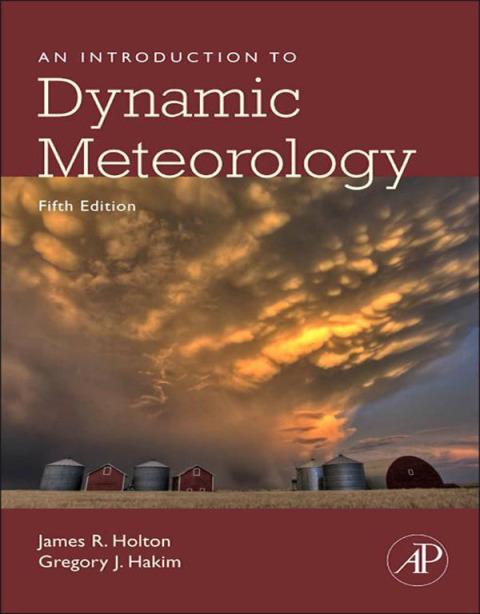Description
Efnisyfirlit
- Cover image
- Title page
- Table of Contents
- Copyright
- Dedication
- Preface
- Chapter 1. Introduction
- 1.1 Dynamic Meteorology
- 1.2 Conservation of Momentum
- 1.3 Noninertial Reference Frames and “Apparent” Forces
- 1.4 Structure of the Static Atmosphere
- 1.5 Kinematics
- 1.6 Scale Analysis
- Suggested References
- Chapter 2. Basic Conservation Laws
- 2.1 Total Differentiation
- 2.2 The Vectorial Form of the Momentum Equation in Rotating Coordinates
- 2.3 Component Equations in Spherical Coordinates
- 2.4 Scale Analysis of the Equations of Motion
- 2.5 The Continuity Equation
- 2.6 The Thermodynamic Energy Equation
- 2.7 Thermodynamics of the Dry Atmosphere
- 2.8 The Boussinesq Approximation
- 2.9 Thermodynamics of the Moist Atmosphere
- Suggested References
- Chapter 3. Elementary Applications of the Basic Equations
- 3.1 Basic Equations in Isobaric Coordinates
- 3.2 Balanced Flow
- 3.3 Trajectories and Streamlines
- 3.4 The Thermal Wind
- 3.5 Vertical Motion
- 3.6 Surface Pressure Tendency
- Chapter 4. Circulation, Vorticity, and Potential Vorticity
- 4.1 The Circulation Theorem
- 4.2 Vorticity
- 4.3 The Vorticity Equation
- 4.4 Potential Vorticity
- 4.5 Shallow Water Equations
- 4.6 Ertel Potential Vorticity in Isentropic Coordinates
- Suggested References
- Chapter 5. Atmospheric Oscillations: Linear Perturbation Theory
- 5.1 The Perturbation Method
- 5.2 Properties of Waves
- 5.3 Simple Wave Types
- 5.4 Internal Gravity (Buoyancy) Waves
- 5.5 Linear Waves of A Rotating Stratified Atmosphere
- 5.6 Adjustment to Geostrophic Balance
- 5.7 Rossby Waves
- Suggested References
- Chapter 6. Quasi-geostrophic Analysis
- 6.1 The Observed Structure of Extratropical Circulations
- 6.2 Derivation of the Quasi-Geostrophic Equations
- 6.3 Potential vorticity derivation of the QG equations
- 6.4 Potential Vorticity Thinking
- 6.5 Vertical Motion (w) Thinking
- 6.6 Idealized Model of a Baroclinic Disturbance
- 6.7 Isobaric Form of the QG Equations
- Suggested References
- Chapter 7. Baroclinic Development
- 7.1 Hydrodynamic Instability
- 7.2 Normal Mode Baroclinic Instability: A Two-Layer Model
- 7.3 The Energetics of Baroclinic Waves
- 7.4 Baroclinic Instability of a Continuously Stratified Atmosphere
- 7.5 Growth and Propagation of Neutral Modes
- Suggested References
- Chapter 8. The Planetary Boundary Layer
- 8.1 Atmospheric Turbulence
- 8.2 Turbulent Kinetic Energy
- 8.3 Planetary Boundary Layer Momentum Equations
- 8.4 Secondary Circulations and Spin Down
- Suggested References
- Chapter 9. Mesoscale Circulations
- 9.1 Energy Sources for Mesoscale Circulations
- 9.2 Fronts and Frontogenesis
- 9.3 Symmetric Baroclinic Instability
- 9.4 Mountain Waves
- 9.5 Cumulus Convection
- 9.6 Convective Storms
- 9.7 Hurricanes
- Suggested References
- Chapter 10. The General Circulation
- 10.1 The Nature of the Problem
- 10.2 The Zonally Averaged Circulation
- 10.3 The Angular Momentum Budget
- 10.4 The Lorenz Energy Cycle
- 10.5 Longitudinally Dependent Time-Averaged Flow
- 10.6 Low-Frequency Variability
- 10.7 Numerical Simulation of the General Circulation
- 10.8 Climate Sensitivity, Feedbacks, and Uncertainty
- Suggested References
- Chapter 11. Tropical Dynamics
- 11.1 The Observed Structure of Large-Scale Tropical Circulations
- 11.2 Scale Analysis of Large-Scale Tropical Motions
- 11.3 Condensation Heating
- 11.4 Equatorial Wave Theory
- 11.5 Steady Forced Equatorial Motions
- Suggested References
- Chapter 12. Middle Atmosphere Dynamics
- 12.1 Structure and Circulation of the Middle Atmosphere
- 12.2 The Zonal-Mean Circulation of the Middle Atmosphere
- 12.3 Vertically Propagating Planetary Waves
- 12.4 Sudden Stratospheric Warmings
- 12.5 Waves in the Equatorial Stratosphere
- 12.6 The Quasi-Biennial Oscillation
- 12.7 Trace Constituent Transport
- Suggested References
- Chapter 13. Numerical Modeling and Prediction
- 13.1 Historical Background
- 13.2 Numerical Approximation of the Equations of Motion
- 13.3 The Barotropic Vorticity Equation in Finite Differences
- 13.4 The Spectral Method
- 13.5 Primitive Equation Models
- 13.6 Data Assimilation
- 13.7 Predictability and Ensemble Forecasting
- Suggested References
- Appendix A: Useful Constants and Parameters
- Appendix B: List of Symbols
- Appendix C: Vector Analysis
- C.1 Vector Identities
- C.2 Integral Theorems
- C.3 Vector Operations in Various Coordinate Systems
- Appendix D: Moisture Variables
- D.1 Equivalent Potential Temperature
- D.2 Pseudoadiabatic Lapse Rate
- Appendix E: Standard Atmosphere Data
- Appendix F: Symmetric Baroclinic Oscillations
- Appendix G: Conditional Probability and Likelihood
- Index






Reviews
There are no reviews yet.